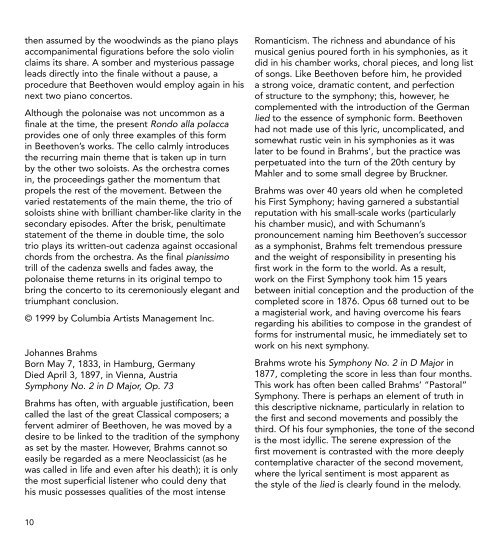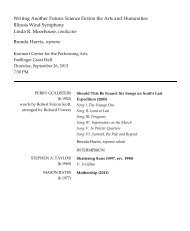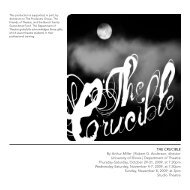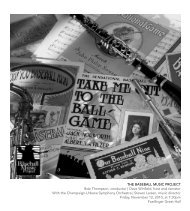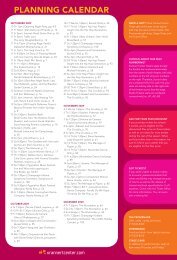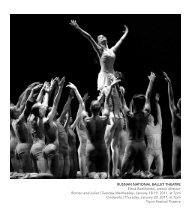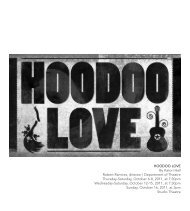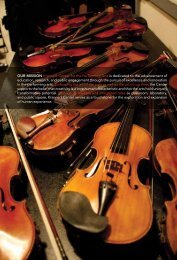VIENNA SYMPHONY ORCHESTRA WITH THE EROICA TRIO Fabio ...
VIENNA SYMPHONY ORCHESTRA WITH THE EROICA TRIO Fabio ...
VIENNA SYMPHONY ORCHESTRA WITH THE EROICA TRIO Fabio ...
Create successful ePaper yourself
Turn your PDF publications into a flip-book with our unique Google optimized e-Paper software.
then assumed by the woodwinds as the piano plays<br />
accompanimental figurations before the solo violin<br />
claims its share. A somber and mysterious passage<br />
leads directly into the finale without a pause, a<br />
procedure that Beethoven would employ again in his<br />
next two piano concertos.<br />
Although the polonaise was not uncommon as a<br />
finale at the time, the present Rondo alla polacca<br />
provides one of only three examples of this form<br />
in Beethoven’s works. The cello calmly introduces<br />
the recurring main theme that is taken up in turn<br />
by the other two soloists. As the orchestra comes<br />
in, the proceedings gather the momentum that<br />
propels the rest of the movement. Between the<br />
varied restatements of the main theme, the trio of<br />
soloists shine with brilliant chamber-like clarity in the<br />
secondary episodes. After the brisk, penultimate<br />
statement of the theme in double time, the solo<br />
trio plays its written-out cadenza against occasional<br />
chords from the orchestra. As the final pianissimo<br />
trill of the cadenza swells and fades away, the<br />
polonaise theme returns in its original tempo to<br />
bring the concerto to its ceremoniously elegant and<br />
triumphant conclusion.<br />
© 1999 by Columbia Artists Management inc.<br />
Johannes Brahms<br />
Born May 7, 1833, in Hamburg, Germany<br />
Died April 3, 1897, in Vienna, Austria<br />
Symphony No. 2 in D Major, Op. 73<br />
Brahms has often, with arguable justification, been<br />
called the last of the great Classical composers; a<br />
fervent admirer of Beethoven, he was moved by a<br />
desire to be linked to the tradition of the symphony<br />
as set by the master. However, Brahms cannot so<br />
easily be regarded as a mere Neoclassicist (as he<br />
was called in life and even after his death); it is only<br />
the most superficial listener who could deny that<br />
his music possesses qualities of the most intense<br />
Romanticism. The richness and abundance of his<br />
musical genius poured forth in his symphonies, as it<br />
did in his chamber works, choral pieces, and long list<br />
of songs. Like Beethoven before him, he provided<br />
a strong voice, dramatic content, and perfection<br />
of structure to the symphony; this, however, he<br />
complemented with the introduction of the German<br />
lied to the essence of symphonic form. Beethoven<br />
had not made use of this lyric, uncomplicated, and<br />
somewhat rustic vein in his symphonies as it was<br />
later to be found in Brahms’, but the practice was<br />
perpetuated into the turn of the 20th century by<br />
Mahler and to some small degree by Bruckner.<br />
Brahms was over 40 years old when he completed<br />
his First Symphony; having garnered a substantial<br />
reputation with his small-scale works (particularly<br />
his chamber music), and with Schumann’s<br />
pronouncement naming him Beethoven’s successor<br />
as a symphonist, Brahms felt tremendous pressure<br />
and the weight of responsibility in presenting his<br />
first work in the form to the world. As a result,<br />
work on the First Symphony took him 15 years<br />
between initial conception and the production of the<br />
completed score in 1876. Opus 68 turned out to be<br />
a magisterial work, and having overcome his fears<br />
regarding his abilities to compose in the grandest of<br />
forms for instrumental music, he immediately set to<br />
work on his next symphony.<br />
Brahms wrote his Symphony No. 2 in D Major in<br />
1877, completing the score in less than four months.<br />
This work has often been called Brahms’ “Pastoral”<br />
Symphony. There is perhaps an element of truth in<br />
this descriptive nickname, particularly in relation to<br />
the first and second movements and possibly the<br />
third. Of his four symphonies, the tone of the second<br />
is the most idyllic. The serene expression of the<br />
first movement is contrasted with the more deeply<br />
contemplative character of the second movement,<br />
where the lyrical sentiment is most apparent as<br />
the style of the lied is clearly found in the melody.<br />
The third movement demonstrates a skillful use of<br />
variation technique and an effective juxtaposition<br />
of alternating fast and moderately slow sections.<br />
The finale expresses great jubilation. All in all,<br />
Opus 73 provides a vivid example of Brahms’ long<br />
melodic lines, his contrapuntal skill as demonstrated<br />
in the combination of melodic lines, the richness<br />
of harmony dictated by seriousness of purpose,<br />
the impressive coherence obtained in the use of<br />
thematic material, and the feeling of balance and<br />
unity in the structure as a whole.<br />
The first movement, Allegro non troppo, is written in<br />
sonata-allegro form. The tranquil opening of basses,<br />
horns, and woodwinds reveals the emotional tone<br />
as well as the musical keynote of the symphony; the<br />
first theme compounds musical ideas to be utilized<br />
later in the work. A second portion of the first theme<br />
is stated in a quiet undulating melody played in<br />
the violins’ high register. A transition builds to a full<br />
climax; this leads into the tender second theme,<br />
which is introduced by the cellos and casts a shade<br />
of melancholy on the previously sunny proceedings.<br />
The development section begins with an elaboration<br />
of the first theme; the intermingling melodies and<br />
vigorous contrasting phrases of the development<br />
finally subside into a quiet passage that leads into<br />
the recapitulation. Here, the return of the first theme<br />
is combined with the second theme winding about<br />
it. The coda that concludes the movement features<br />
an ethereal horn solo.<br />
unlike Mendelssohn and Schumann, for instance,<br />
Brahms followed the practice of the classics by<br />
placing the slow movement as the second instead<br />
of the third movement of his symphonies. The songlike<br />
Adagio non troppo is deeply contemplative in<br />
character with long phrases and rich chromaticism.<br />
The cellos introduce the first theme based on a<br />
descending line, which leads to an accompanying<br />
counterpoint, basically ascending and played by the<br />
bassoons. A transition passage introduces a new key<br />
and leads into the second theme, marked L’istesso<br />
tempo, ma grazioso. A third theme introduces the<br />
development; this section builds up with increased<br />
rhythmic and melodic motion. The recapitulation<br />
brings back the second theme, this time richly<br />
ornamented, before closing with a restatement of<br />
the second theme.<br />
The third movement, Allegretto grazioso, quasi<br />
andantino, is more like a song than a scherzo<br />
and is perhaps closer in style to some of Brahms’<br />
piano pieces labeled Intermezzi. The main<br />
theme, introduced by the oboe with pizzicato<br />
accompaniment from the cellos, suggests the steps<br />
of a dance; however, there is nothing dancelike<br />
about the development section or the richness of<br />
thematic variation in the middle episode.<br />
The last movement, Allegro con spirito, is once again<br />
built on the sonata-allegro form. The principal theme<br />
begins mysteriously in the strings, extends to the<br />
woodwinds, and at last is expounded by the entire<br />
orchestra. The strings also introduce the second<br />
theme. in the development section, Brahms’ mastery<br />
of contrapuntal technique is most evident; here the<br />
composer makes frequent use of broken polyphony<br />
as the thematic threads of melody and counterpoint<br />
are distributed into small and even smaller motifs.<br />
With one last statement of the second theme,<br />
proclaimed by the trumpets, Brahms brings his<br />
Second Symphony to its brilliant conclusion.<br />
© 1994 by Columbia Artists Management inc.<br />
10 11


